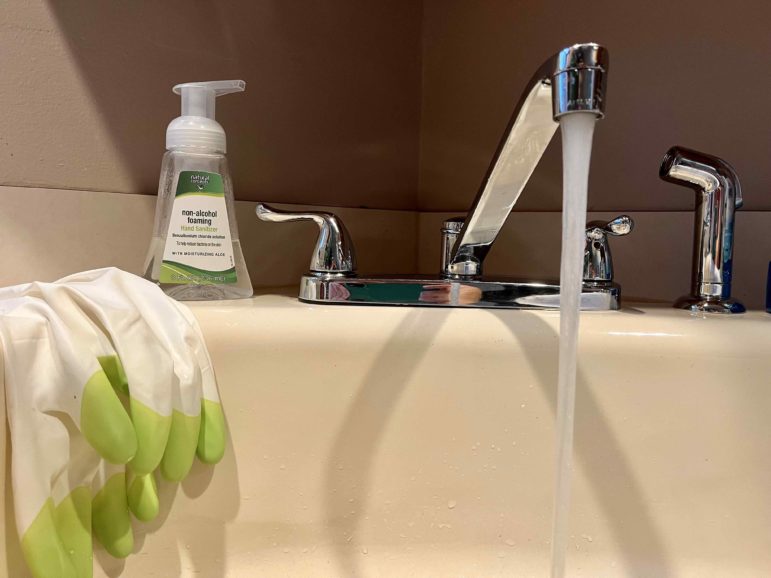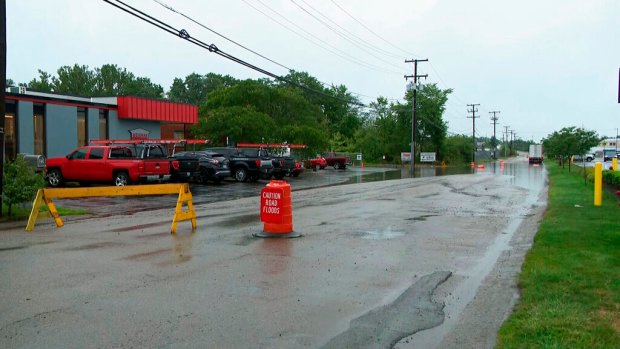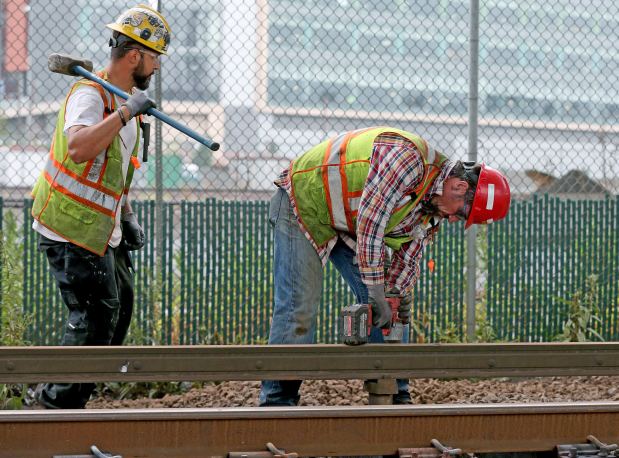The discovery of arsenic in the water supply at NYCHA’s Jacob Riis Houses is a scary reminder of how little control most people have over their taps. While most of the drinking water in New York City apartment buildings is perfectly potable, older plumbing can leach toxins, especially lead, during the final stretch from street to sink.

The discovery of arsenic in the water supply at NYCHA’s Jacob Riis Houses is a scary reminder of how little control most people have over their taps, especially when they rent apartments.
Most New Yorkers have nothing to worry about: Big Apple tap water starts off as the cleanest and most scrutinized supply in the state, with the water originating from 19 reservoirs and three lakes in the Hudson Valley and Catskills before flowing into the five boroughs, where it is subjected to 27,000 tests a month across 1,200 sampling locations overseen by the Department of Environmental Protection (DEP).
“NYC’s tap water is of the highest quality,” said Edward Timbers of the DEP, adding that it “meets or exceeds all state and federal health and safety guidelines.”
But that can vary once the water reaches individual taps, said David Soll, a historian and policy expert whose book “Empire of Water” tells the story of NYC’s H2O. While most of the water in New York City apartment buildings is perfectly potable, older plumbing can leach toxins, especially lead, during the final stretch from street to sink.
“New York City has spent billions of dollars to protect its upstate sources and has generally done an excellent job of this,” Soll said. “However, and this applies not just to New York but to many other cities, it has not done nearly as much to safeguard water quality once water leaves the city’s delivery network.”
A 2018 report by the Independent Budget Office (IBO) examined lead test data from 2006 to 2016 and found that the highest rates of contamination occurred in the neighborhoods of Ridgewood, Maspeth, Bedford-Stuyvesant, Co-Op City, Riverdale and Staten Island’s South Beach neighborhoods. Lead pipes and fittings are especially common in smaller, pre-war buildings, especially those built in the 1920s and 1930s, IBO found.
“Water is not the primary source of lead exposure in New York City,” said Patrick Gallahue of the New York City Department of Health and Mental Hygiene, via email. “That said, lead can enter drinking water from plumbing materials, such as pipes, faucets and fixtures made with lead metal.”
Under federal guidelines, lead levels are considered dangerous when they reach 15 parts per billion, though no amount of lead is safe. The mineral is linked to developmental delays in children, especially kids under 5 years old.
READ MORE: As City Health Dept. Weighs New Lead Paint Standard, a Push for Stricter Enforcement
Homeowners have options: They can pay to replace the pipes, remove lead fittings and address other toxins present in the water. There are even some grants available to help cover the cost.
But renters have little recourse when it comes to lead in their water. Landlords are not mandated to test for toxins or even correct the problems once discovered. The DEP lists buildings equipped with lead pipes on an online interactive map, but the data is incomplete and hard to find, said Jessica Bellinder, supervising attorney in the Legal Aid Society’s Bronx Housing Justice Unit.
“It seems like it’s eminently fixable and we have the data to do that,” Bellinder said. “Better public education would make a lot of sense.”
But for now, most tenants are on their own to learn about lead or other toxins in the faucets at the apartment they just dropped a security deposit on. So what can renters do to keep themselves and their families safe?
Get tested for lead
All New Yorkers can access free water test kits online, which the city says will arrive within 10 days of the order. The test includes two bottles and a pre-paid mailing label allowing residents to return the samples to a laboratory free of charge. The city says it will mail back results within 30 days. (Editor’s note: This really works. David Brand tested water at his last Queens apartment four times using the city’s free test kits and found elevated lead levels in water from the kitchen faucet but none from the bathroom faucet. That was helpful information, but made getting a safe glass of water a little awkward at times.)
To get a test shipped to your house, click here or call 311.
In the meantime, tenants can purchase a filter that attaches to their sink or a pitcher to reduce lead exposure. But they aren’t cheap, they require routine replacement and they can take up to an hour to filter a relatively small amount of water. Plus, not every device is equipped to limit lead. Consumer Reports ranked the best and worst filters earlier this year.
If tests reveal elevated lead levels, residents may have to resort to “work-arounds,” Soll said. They can try running the water if the pipes have not been used for several hours or drinking and cooking with bottled water instead of tap, he said.
Boiling water will not remove or destroy lead, however. And running the faucet hot tends to strip more leads from pipes, leading to a higher level of the toxin in drinking water. The city’s health department recommends families use cold water to make baby formula and for drinking and cooking, said Gallahue.
Erik Olson, advocacy director of drinking water campaigns for the National Resources Defense Council, pointed to handy tips New Yorkers can use to test their pipes, including using a coin to see if the pipe is easily scraped or checking whether a magnet will stick to it. A non-magnetized, soft pipe typically means it is made of lead, he said.
“There are a lot of people that are drinking from lead pipes that don’t know it,” he said.
Olson recommends New York City residents who live in a building with lead service pipes use a filter that has been certified to remove lead. Ideally the owner would replace the pipes, he said. “But that can be a very costly endeavor unless your city is willing to foot the bill,” he added. “Landlords generally are reluctant to spend a nickel on replacing their lead service lines unless the city steps in and pays for 100 percent of them.”
The Bipartisan Infrastructure Law passed by Congress and signed by President Biden last year carves out over billions of dollars for replacing lead pipes and removing lead from drinking water. Eventually, New York City or State could use that money to incentivize building owners.
“New York City needs to get in line to have a more serious lead service line replacement program that will pull out all these lead service lines,” said Joan Matthews of NRDC.
Testing for other toxins?
Toxins other than lead are a different story.
While the DEP routinely tests the city’s water supply for arsenic and other potential contaminants, it may be impossible for everyday New Yorkers to find out what’s flowing from their faucets without forking over some cash. Commercial tests run from $25 for an at-home kit to $140 for an intensive examination by an accredited agency.
“If you only test for lead, it’s going to be about $50. If you test for arsenic, it’s going to be maybe $50 to $100. If you do a broad spectrum test, you could run into the hundreds of dollars,” said Olson.
If you can afford it, the tests may be worth the cost: Arsenic exposure can cause nausea, vomiting, abnormal heart rate, damage to blood vessels and a “pins and needles” sensation in the hands and feet, according to the state Department of Health. And although the dangers of lead exposure are usually targeted to children and pregnant women, Olson notes it can cause health issues in adults, including elevated blood pressure and cardiovascular disease.
The DEP releases a report each year on levels of the several dozen contaminants it tests for, including lead and arsenic. Last year’s report, the most recent available, shows that no levels of arsenic were found in the drinking supply.
Still, it remains unclear exactly how the arsenic got into the water supply at the Riis Houses. While individual wells, like the kind found in rural or suburban properties, can leach arsenic, it is rarely present in urban settings, said Stoll.
“If, as appears to be the case, the problem is confined to the Riis Houses, then something out of the ordinary is going on there that is likely not occurring elsewhere,” he said. “This is what the city needs to figure out.”
But NYCHA waited two weeks to disclose the arsenic tests to tenants, according to news reports, and did not begin alerting residents until a reporter from The City contacted the agency. On Friday, city officials, including Mayor Eric Adams, cautioned residents not to drink the tap water and handed out bottles instead.
On Saturday, a Riis Houses resident sent City Limits an advisory that NYCHA shared with tenant leaders, who in turn circulated the information among neighbors.
“Do not drink the water in your apartment or use the water for cooking,” the advisory reads, adding that the agency will provide bottled water to residents and take samples from every apartment.
By Monday, NYCHA said tests no longer revealed traces of arsenic in the water—though the water has remained cloudy, tenants said. Resident Sharon Stergis said she remained reluctant to fill up a glass from her faucet.
“That’s a big old No,” Stergis said when asked if she would drink the water in her apartment again.
“We’ve been buying and filtering our water here for generations,” she added. “This is just confirmation.”
That justifiable fear turns water from a public right into a pricey commodity—potentially foreshadowing a future where climate change further contaminates taps.
Last November, New York voters overwhelmingly approved adding “the right to clean air and water” to the state constitution, but the provision has yet to be tested in court as it relates to drinking water.
The constitutional amendment that was adopted last November is brand new and completely untested, said Michael Gerrard, an environmental law professor at Columbia University. “We don’t really know yet what, if any, teeth the courts will find it has.”
In the immediate term, Soll, the New York City water historian, said officials must get to the bottom of the arsenic contamination at the Riis Houses.
“What’s happening at the Riis Houses is a crisis and needs to be treated as such,” Soll said. “But it should be a wake-up call to city and state officials to address deep-seated problems like lead service pipes.”










